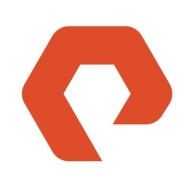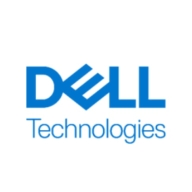


Both Dell Unity XT and Dell VMAX All Flash are high-performance storage solutions. Dell VMAX All Flash holds an advantage in features, while Dell Unity XT is favored for its deployment ease and cost efficiency.
Features: Dell Unity XT offers simplicity, scalability, and robust data services. Dell VMAX All Flash provides superior performance, comprehensive data protection, and advanced integration capabilities. Dell VMAX All Flash holds more advanced functionalities compared to Dell Unity XT.
Room for Improvement: Dell Unity XT needs better integration with third-party applications, an improved reporting system, and enhanced user documentation. Dell VMAX All Flash could improve cost-effectiveness, a more user-friendly management system, and reduced complexity for initial deployment. Cost-related issues are more prominent for Dell VMAX All Flash users.
Ease of Deployment and Customer Service: Dell Unity XT is commended for straightforward deployment and effective customer service. Dell VMAX All Flash, though more complex to deploy, benefits from professional support that addresses its sophisticated setup. Dell Unity XT is seen as easier to deploy, while Dell VMAX All Flash's professional support offsets its complexity.
Pricing and ROI: Dell Unity XT is generally more affordable with a better upfront cost and reasonable ROI. Dell VMAX All Flash, while more expensive, offers a higher ROI in the long term due to its enhanced features and performance reliability. Dell Unity XT stands out for initial cost efficiency, whereas Dell VMAX All Flash promises greater long-term value.



Pure Storage FlashArray//X is the world’s first enterprise-class, all-NVMe flash storage array. It represents a new class of storage – shared accelerated storage, which is a term coined by Gartner – that delivers major breakthroughs in performance, simplicity, and consolidation.
Dell EMC Unity XT is one of the best all-flash storage arrays on the market today. Dell EMC Unity XT arrays are designed for performance, optimized for efficiency, and built for a multi-cloud world. In addition, they support digital transformation, enabling businesses to reach the full potential of their data capital quickly and easily. Dell EMC Unity’s All-Flash and Hybrid Flash storage platforms provide the performance, efficiency, enterprise-class software, and virtualization integrations required for running a wide range of virtualized applications.
Dell EMC Unity XT Features
Dell EMC Unity XT has many valuable key features, including:
Dell EMC Unity XT Benefits
Some of the benefits of using Dell EMC Unity XT include:
Reviews from Real Users
Below are some reviews and helpful feedback written by Dell EMC Unity XT users.
A Systems Engineering Manager at a manufacturing company says, "It is definitely one of the most robust, solid, well-performing products that I have dealt with. It is set it and forget it, which is pretty amazing." He also mentions, “We can do both block and file storage on one unit without purchasing a separate device.”
Peter S., Senior Technical Specialist at a healthcare company, states, “The most valuable feature is reliability. At the end of the day, it just runs. This solution is easy to work with and easy to maintain.”
PeerSpot user Melvin T., Senior Systems Engineer at Prosperity Bank, explains that the solution is “easy to use and we can add LUNs or space without interruption to end-users. We're able to access it from just about anywhere, as long as we have access to a browser. That feature is really neat because sometimes we will go to a different data center or a different site, and if we need to access it to see a LUN or to see any type of storage, we can do that. That's one of the big takeaways with Unity."
Dell VMAX All Flash is utilized in hyper-converged solutions like VxRail deployments, critical for Data Domain in backup tasks. It supports multi-site replication, disaster recovery, banking IT operations, and high-performance applications.
Dell VMAX All Flash plays a key role in data-intensive environments due to its robust capabilities in storage, data protection, and high throughput tasks. It is crucial in hyper-converged solutions and VxRail deployments, facilitating multi-site replication and disaster recovery. Its applications span across banking and other critical IT operations requiring high performance. The system's ability to support efficient data compression and provide ransomware protection addresses significant security concerns. Multi-site replication and redundancy safeguard data even during power outages or hardware failures, while the snapshot feature aids in testing, application development, and environment management.
What are the key features of Dell VMAX All Flash?Dell VMAX All Flash is critical in industries like banking, where it supports IT operations requiring high performance, and in environments demanding stringent data protection measures. Its role in multi-site replication and disaster recovery makes it invaluable for business continuity and critical data security across sectors.
We monitor all All-Flash Storage reviews to prevent fraudulent reviews and keep review quality high. We do not post reviews by company employees or direct competitors. We validate each review for authenticity via cross-reference with LinkedIn, and personal follow-up with the reviewer when necessary.